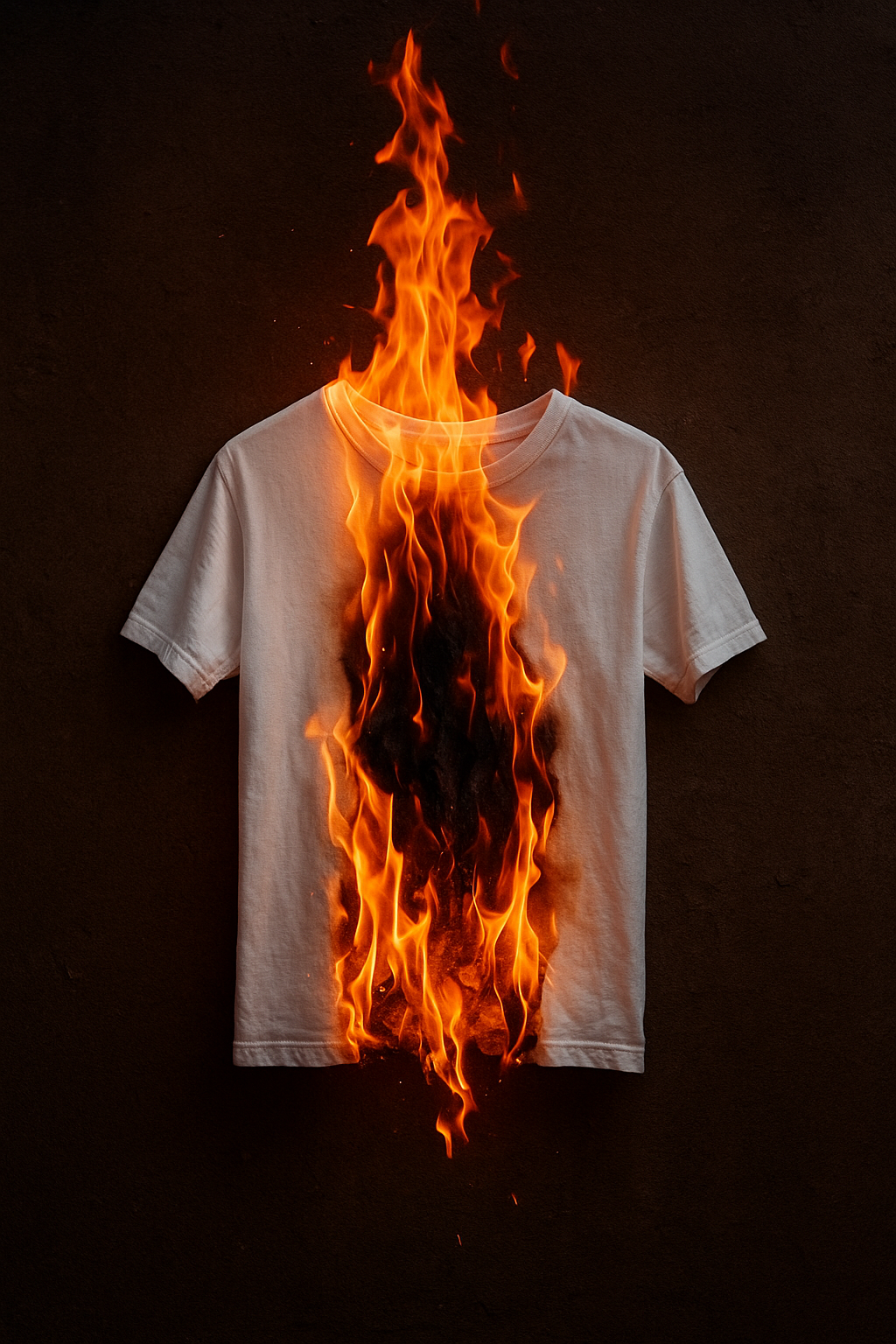Flammable Clothing Lawsuits
Product Liability Lawyer investigating burn injury & consumer burn hazards
Flammable clothing poses serious risks for adults and children alike, leading to severe burns, long-term medical complications, and permanent scarring. Victims of these injuries may have legal options to pursue compensation through flammable clothing lawsuits.
Victims of burn injuries caused by flammable clothing may bring claims under product liability law. These cases typically argue one or more of the following:
-
Defective Design – The clothing design itself made the garment unreasonably dangerous.
-
Manufacturing Defect – A flaw in production caused the garment to be more flammable than intended.
-
Failure to Warn – The manufacturer failed to provide adequate warnings about fire risks.
Federal law provides some protection through the Flammable Fabrics Act, which sets safety standards for clothing, upholstery, and other textiles. However, recalls and lawsuits reveal that dangerous clothing continues to enter the market.
What Makes Clothing Flammable?
Clothing becomes dangerous when it is made with materials that ignite easily or burn rapidly. Some fabrics, particularly lightweight synthetics, are more likely to catch fire and cause serious burn injuries. Contributing factors include:
-
Fabric type: Rayon, nylon, and untreated cotton may ignite faster than wool or flame-retardant fabrics.
-
Loose-fitting garments: Robes, nightgowns, and costumes with flowing fabric can catch fire quickly.
-
Lack of treatment: Some clothing fails to meet Consumer Product Safety Commission (CPSC) flammability standards requiring flame-resistant treatment.
-
Design flaws: Fringe, tassels, and layered fabrics may accelerate burning.
It may come as a surprise that children’s clothing manufacturers typically do nothing to make their products flame resistant. Flame-resistant fabrics are rare, and in fact, U.S. regulators do not require them in children’s clothing. As a result, many children, as well as adults, suffer burn injuries, often when clothing is ignited.
It is estimated that around 4,000 people in the U.S. are injured from flammable clothing accidents each year, many of them children. In one burn injury study, more than 50 percent of burn accidents were associated with clothing ignition. Children account for over 40 percent of clothing ignition accidents.
In a related burn injury risk clothing recall, Allura recalled around 64,000 pairs of children’s pajamas over fire and burn risk, according to the U.S. Consumer Product Safety Commission.
The pajamas—Allura’s “Sweet and Sassy” 100 percent polyester fleece pajama pants, and a onesie under the brand name Delia’s Girl—were also sold online at Amazon.com, CookiesKids.com, and CrazyforBargains.com. The CPSC states that the pajamas do not meet flammability standards and pose a risk of burn injury.
Joe Lyon is a highly-rated personal injury attorney investigating burn injury cases and flammable clothing lawsuits for plaintiffs nationwide.
Flammable Clothing Regulations
The 1953 U.S. Flammable Fabrics Act is supposed to protect the consumer from clothing that could easily ignite and cause burn injury. Flammability regulations require clothing to meet certain standards of durability and flame resistance. When clothing is made of inferior materials or produced in a negligent manner, manufacturers may be held liable following injuries.
The Consumer Product Safety Commission (CPSC) requires that clothes sold in the United States pass flammability tests. If you have been injured after your clothing caught fire too easily, you should contact a burn accident experienced in filing flammable clothing lawsuits.
Consumer and product safety experts have warned of negligent clothing manufacturing processes that endanger consumers, and increase the risk of burn injury. To the dismay of most Americans buying clothes, certain textiles and clothing may contain flammable fabrics that may easily catch fire and burn rapidly.
The United States government has tried to protect the consumer since the 1950s when Congress enacted the Flammable Fabrics Act (FFA). The law classifies fabrics into the following categories:
- Class 1: Normal Flammability
- Class 2: Intermediate Flammability
- Class 3: Rapid and Intense Burning
Combustible fabrics in Class 3 are regulated and prohibited from being sold in wearable clothing in the U.S. Laws and regulation regarding the flammability of children’s sleepwear is more stringent.
There are several factors that can contribute the flammability of a fabric, including the raw materials used, the gauge of the knit, the weight of the fabric, any dyes and chemicals used to treating the fabric.

Clothing Burn Accidents & Injury
During flammable fabrics testing, a sample fabric is held to a flame and the time it takes for the flame to cover 5.5 inches is recorded. This kind of testing is not always effective and many fabrics are passed but may still present a serious burn injury risk to consumers. Generally, the flammability of fabrics is assessed by the following:
- Types of Fiber: fibers like untreated cotton ignite quite easily and burn fast. Wool is more difficult to ignite and burns slowly.
- Tightness of Weave or Knit: loose fabrics ignite and burn faster.
- Fabric Density: The denser the fabric, the more resistant it is to flame and burning.
- Surface Finish: Some treatments can improve a fabric’s resistance to ignition and burning. Conversely, other treatments and finishes can feed flammability.
- Fit on Body: A tight fitting garment helps to harness the spreading of flame and fire.
Understanding Clothing Flammability
In general, a clothing fire hazard depends on the material, weight and construction of the item. Different clothing fabrics burn in unique ways, and depends largely on the weave, and fit.
For example, cotton and linen burn hot and fast, and synthetic fibers can melt into the skin but generally flame out quickly. Wool and silk clothing burns slowly and are difficult to ignite. The heavier the fabric, the higher its flame resistance, and the slower its burning characteristics. Materials made of cotton and rayon generally have the fastest burning characteristics, and pose the greatest risk.
Another factor is the weave. If the fiber structure of the fibers is loose, the fabric is more likely to ignite. Also, clothes that fit closer to the body are less likely to accidentally come in contact with a flame source.
Victoria’s Secret Lawsuit
The danger of flammable clothing is not limited to children’s clothes.
Recently, a high-profile flammable clothing claim was filed against Victoria’s Secret after a 22-year-old woman claimed she suffered painful burns and blisters after her Victoria Secret Demi Bra leaked fluids.
The lady said she bought the bra in December 2015 on the Victoria’s Secret website. She filed an injury claim after she was allegedly left with burns, blisters, scarring and discoloration after the clothing accident. The lawsuit states the bra “leaked and exploded.” She did seek medical treatment after the accident and is seeking damages related to the burn injury.
The Demi bra has been discontinued by Victoria’s Secret but there is no indication of why it is no longer in production. The push-up style bra meant to conform to the wearer’s shape. Attorneys and experts are investigating potential causes of injury.
In 2017, another plaintiffs sued Victoria’s Secret and claimed she suffered third-degree burns after one of its hoodies accidentally touched a gas stove and burst into flames. The sweatshirt was part of the company’s PINK line.
The plaintiffs suffered third-degree burns. Attorneys sought compensation for medical expenses and punitive damages for product liability, gross negligence, negligent design and a failure to warn consumers of the fire risk.
Victoria’s Secret has been sued numerous times by women alleging product liability, claiming they were either burned or suffered other injuries.
Flammable Clothing Risk Factors
Fabric and other manufacturing factors affect burn injury incidence, and companies may be held liable for failing to warn consumers of certain risks of their product. Children’s clothing manufacturers and distributors have a responsibility to protect young kids when possible, and when that duty is not met, it may be prudent to hire a burn injury attorney and take legal action against the negligent company.
Product liability lawsuits can end in large settlements, recovering damages and medical expenses, and also may include punitive damages against a company so they are more likely to provide consumers with a safer product in the future.
Examples of Flammable Clothing Cases
-
Children’s Pajamas: Multiple recalls have involved children’s sleepwear that failed to meet flammability standards, resulting in severe burn risks.
-
Halloween Costumes: Costumes with synthetic fabrics and loose designs have been linked to rapid ignition when exposed to candles or open flames.
-
Workplace Uniforms: Some workers in industrial and food service settings have suffered injuries when uniforms failed to resist ignition.
-
Everyday Clothing: Robes, sweaters, and jackets have been recalled for failing to meet federal safety standards.
CONTACT THE LYON FIRM TODAY
Please complete the form below for a FREE consultation.
ABOUT THE LYON FIRM
Joseph Lyon has 17 years of experience representing individuals in complex litigation matters. He has represented individuals in every state against many of the largest companies in the world.
The Firm focuses on single-event civil cases and class actions involving corporate neglect & fraud, toxic exposure, product defects & recalls, medical malpractice, and invasion of privacy.
NO COST UNLESS WE WIN
The Firm offers contingency fees, advancing all costs of the litigation, and accepting the full financial risk, allowing our clients full access to the legal system while reducing the financial stress while they focus on their healthcare and financial needs.

Damages Available in Flammable Clothing Lawsuits
Burn injuries often require extensive medical care and can have lifelong consequences. Victims may pursue compensation for:
-
Medical expenses (emergency care, surgeries, rehabilitation)
-
Lost wages and loss of earning capacity
-
Pain and suffering
-
Emotional distress
-
Permanent scarring or disfigurement
-
Wrongful death damages (in fatal cases)
CONTACT THE LYON FIRM TODAY
Questions about Flammable Clothing Lawsuits
Cellulose fibers like cotton, linen and rayon may easily catch fire, and the flames can spread rapidly if the textile has not been treated with a flame retardant. The thinner and lighter the fabric, the easier it burns.
It more common than many people think. One study noted an estimated 3,000 deaths and 150,000 injuries occur annually in the US from burning clothing.
Yes, there are standards in which companies must abide by to protect consumers, particularly in regard to children’s clothing. Design and manufacturing defects result in thousands of product recalls each year in the United States, initiated by federal safety agencies. Following injury and illness, regardless of recall status, victims and plaintiffs may pursue legal action and contact a product liability lawyer to begin the litigation process. Rightful compensation can be sought and help plaintiffs recover medical costs and other related damages.
Product liability law overlaps with regulatory law, which are the systems of legislative rules and administrative agencies, and part of federal and state governments.
The Flammable Fabrics Act was enacted in 1954 in order to reduce the danger of injury and loss of life by providing standard methods for testing and rating the flammability of textiles and clothing. The act was designed to cover only those fabrics coming in contact with the body, not including industrial fabrics and fabrics used for drapes, bedding, and floor coverings.
Victims may recover damages for medical costs, lost income, pain and suffering, disfigurement, and more.
Because these cases involve technical product liability law, expert testimony, and negotiations with corporations, having an experienced attorney like The Lyon Firm is crucial.
Manufacturers, distributors, and retailers may all be held responsible if their negligence led to unsafe products reaching consumers.
Why Hire The Lyon Firm?
Burn injury cases are among the most complex areas of product liability law. They require extensive investigation, expert testimony, and a compassionate understanding of the long-term impact of catastrophic injuries.
The Lyon Firm has decades of experience representing plaintiffs in product liability and burn injury lawsuits. The firm works with safety engineers, medical experts, and fire investigators to build strong cases against negligent manufacturers.
Joe Lyon and his team have successfully litigated cases nationwide, securing compensation for victims while demanding higher safety standards from corporations. The Lyon Firm is dedicated to ensuring that victims and families receive justice while contributing to broader consumer safety reforms.
Burn Hazard Information Center
- Propane Heaters
- Space Heaters
- Nutri-Bullet Blenders
- Scalding Soup Burns
- Flammable Cosmetics
- Crock Pots
- Hydrochloric Acid
- Hydrogen Sulfide
- Sulfuric Acid
- Burn Treatment Centers
- Electrocution
- Chemical Burn
- Thermal Burn
- Portable Power Banks
- Pressure Cookers
- Patio Heater
- Vornado Space Heater
- Cosmetics
- Product Recall
- Toxic Exposure
- Industrial Injuries
Request A Free Consultation
-
-
Answer a few general questions.
-
A member of our legal team will review your case.
-
We will determine, together with you, what makes sense for the next step for you and your family to take.
-
